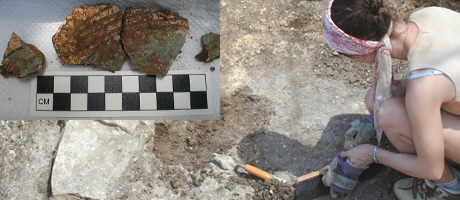A fragment of a painting more than 3,500 years old shows a white arc on a bright blue background. It might be a bird, a griffin, a ship or something else entirely. And there are many more fragments that have been lying underground in Israel for three millennia, waiting for archaeologists to find them and art conservators to fit them together like puzzle pieces.
While it is not yet evident what the fragment depicts, what is clear is that it was painted in a distinctly Greek style, a first for the region and time period.
The fragments were discovered at Tel Kabri, the ruins of a city that dates back to approximately 1700 B.C. Located in northern Israel, the 30-hectare site once housed a palace and complex of buildings inhabited by the Canaanites, who lived in much of Israel, Jordan, Lebanon and Syria before the Israelites conquered the territory. In Biblical terms, the city was built and inhabited for about 300 years between the time of Abraham and Moses.
Unearthing the site and discovering what its architecture and artifacts can tell us about the ancient civilization is the job of Eric Cline, GW professor of classical and Semitic languages and literatures, and his counterpart Assaf Yasur-Landau of the University of Haifa. The two scholars led an archaeological team of 66 students, faculty and volunteers on a six-week expedition to Tel Kabri last summer.
Tel Kabri is unique in that after it was deserted no other settlements were built on top of its ruins, preserving many artifacts and making it the only Canaanite city from that period that can be excavated in its entirety, says Dr. Cline. Now covered with avocado and banana groves, Tel Kabri’s palatial ruins were only discovered in the 1960s when work for an irrigation pipe cut through the area. An initial expedition by Israeli and German archaeologists took place from 1986 to 1993, after which the site again lay abandoned until Dr. Cline’s group was granted permission to excavate it beginning in 2005.
The most surprising finding at Tel Kabri has been the painting fragments, as well as an elaborate plaster floor also painted in the Greek style, and what they indicate about a connection to Bronze Age Aegean culture. “Regional artistic influences normally came to this area from Mesopotamia, the area of present-day Iraq, located to the north,” Dr. Cline explains. “This represents the first good evidence of Minoan artisans working in ancient Canaan 3,500 years ago.”
It may be that the inhabitants of Tel Kabri were trying to differentiate themselves from some of their rivals, who traded heavily with Mesopotamia, and therefore sought out a western trade route, or it may be that Greek artisans, who had recently experienced a devastating volcanic eruption on the island of Santorini, were wandering eastward. “We may never know,” says Dr. Cline.
Originally part of a wall painting, the fresco fragments were found face down on the ground, which helped preserve their color. “For some reason, someone had torn the painting off the wall,” says Dr. Cline.
Another mystery is why the site was abandoned during the 16th century B.C. “A rival site down the road may have knocked it off, but there’s no clear sign of fire or other destruction everywhere, which we would expect,” says Dr. Cline. It will be decades before the site is completely excavated, Dr. Cline adds.
“Being on the site of an ancient ruin was fascinating,” says GW student Melissa Cradic, who took part in the dig at Tel Kabri. “You never knew what to expect, be it architecture, pottery or painted plaster fragments.”
Ms. Cradic was one of 28 participating GW students, most of whom earned college credit for their part in the excavation. Other volunteers were of all ages and professions and hailed from 10 countries, including England, Ireland, Finland, Austria, Australia, Canada, Romania and Croatia.
Excavations, which took place during the cooler, early morning hours, proved physically strenuous since the artifacts are buried under several feet of earth. “My role was that of a volunteer excavator—mostly this entailed heavy physical labor using pick-axes, dirt buckets and wheelbarrows,” says Ms. Cradic. “I helped uncover pottery and more of the palace architecture, including a raised walkway.” Afternoons were spent assessing and cataloguing findings.
Dr. Cline, who will return to Tel Kabri next summer with another team, says the experience of an archaeological dig is unparalleled. “There’s nothing like walking on ancient ground and feeling the absolute mystery, wonder and curiosity of what lies below,” he says.
Comments? Criticism? The conversation continues. We welcome reactions, commentary and story recommendations on our Facebook page.


